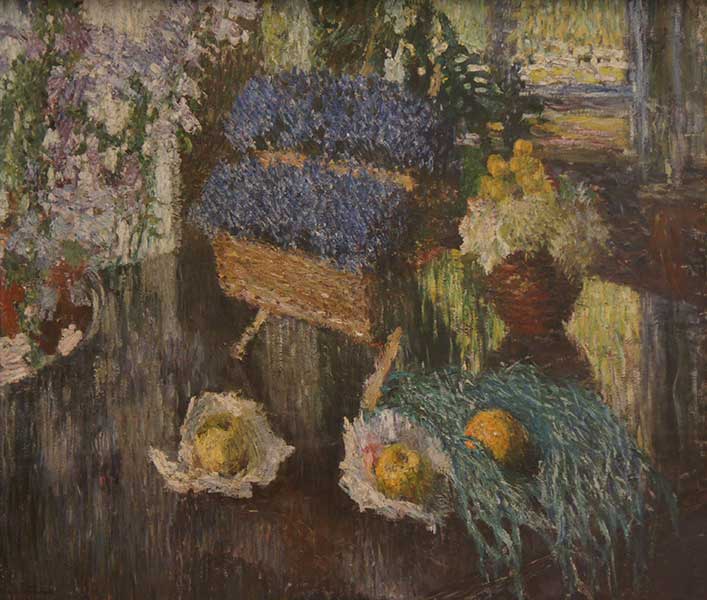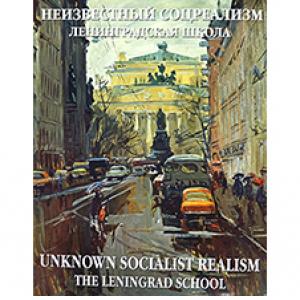Evsey Moiseyenko: Master of Thematic Paintings
by Cathy Locke
Evsey Moiseyenko (1916-1988) was an amazing Russian artist who is virtually unknown in the West. Trained in the tradition of Soviet Realism, Moiseyenko was able to forge a new expressive style of painting that established him as one of the most famous painters of the Leningrad School in Russia. As a beloved Jewish painter from rural Russia, his very life chronicles the life and death of the Soviet government. Born one year before the Bolshevik revolution at a time when all of Russia embraced a new government, Moiseyenko died at the height of perestroika, when the people of Russia had lost faith in Soviet regime. Although he was raised during the tense creative restrictions of the Stalin years, Moiseyenko was able to develop his own unique voice that spoke to his ideals and beliefs.
Moiseyenko was born into a peasant family in Uvarovichi, a small rural village in Belarus, an area known as White Russia during the time of his birth. In 1936 he enrolled in the Academy of Art (known today as the Repin Institute) in St. Petersburg. Classes were interrupted by the war on July 5, 1941 at which time the artist joined the national militia. He was captured by the Nazis during their approach to St. Petersburg and imprisoned until the end of World War II at Altengrabov, a concentration camp. Had he not been captured, he almost certainly would have died in the war. This chapter of his life had a dramatic effect on his work as an artist. Directly after the war Moiseyenko was able to finish his studies and complete his thesis painting, General Dovator. This first major painting became the riding theme of his future work. General Dovator was an actual person who became the symbol of the epic power of the Russian people during their heroic struggles of World War II. Moiseyenko depicts the most dramatic moment when the two hostile forces collide in battle. In June of 1947 he presented General Dovator to the graduate committee of the Academy of Art. He was awarded the title of artist-painter and was admitted into the Leningrad branch of the Union of Soviet Artists. In 1958 Moiseyenko became a professor at the Academy of Art.
For the next thirty years Moiseyenko worked on a series of paintings titled The Years of Fighting, devoted to World War II. Initially the work was done in a tight representational style focusing on compositions of heroic battles, clearly following Stalin’s mandate to paint only in the style of Soviet Realism. With the loosening of creative restrictions brought about by the Khrushchev Thaw in the 1960s Moiseyenko’s work started to loosen up and became more abstract. In his sketches for paintings in the 1960s, Comrades and Red Came, we see the emergence of his unique voice. By the end of the 1960s Moiseyenko had developed a trademark expressive style that was full of emotion. This body of work continued to evolve naturally throughout Moiseyenko’s life. As time went on the artist depicted not only soldiers in glory, but the harshness of war and poignant moments from his own life.
His painting, Red Came, is based on personal memories from his childhood in Belarus. He writes: "I remember being a kid in a remote village standing behind a wooden fence, I enthusiastically watched the dusty horses of the Red Army run through the marsh land past me. The horses were foaming at the mouth, they seemed to me to be giants.”1
Among his paintings of soldiers and horses in his series The Years of Fighting are a number of lovely portraits. Author Elena Lutovchenko writes, “Moiseyenko did not invent his heroines. He found them among the inhabitants of his village.2” Moiseyenko’s painting, Mother, Sister, is the “embodiment of the hard life of Moiseyenko’s mother, Marya Sergeyevna, whose fate was that of many women of her generation. Early widowed, she was left with two children from her husband's family.2” In 1967, Moiseyenko was awarded best painting of the year by the Leningrad Department of Culture for Mother, Sister. The artist said, “I remember how my mother saw me off to war. Later as a soldier I passed many villages with mothers saying goodbye to their sons. I will never forget the eyes of these women. The memory of their grief, sorrow and hope settles in the soul of a soldier."
As Moiseyenko’s style matured his subject matter started to incorporate people in Russia’s countryside. The Crimea area where his wife, Valentina Lavrentevna, had been raised and her parents lived inspired many of these paintings, in addition to visits to his mother in Uvarovichi. From these two places he painted portraits of villagers and children, small landscapes, as well as still lifes of household items. In his painting, Yesenin with his Grandfather (1964), he depicts the famous poet Sergei Yesenin (1895-1925) with his grandfather. Both Yesenin and Moiseyenko grew up in the same village and their grandfathers acted as their first teachers to help them interprete life. “In his mature work the artist addresses the theme of continuity, a living link between generations, the painting Sergei Yesenin with his Grandfather is purely autobiographical.”3 Yesenin’s grandfather becomes a symbol of moral support and a protector of youth. There are two versions of this painting; both were found in Moiseyenko’s studio after his death and were given to the Russian Museum in St. Petersburg.
In the 1970s Moiseyenko’s work on his series The Years of Fighting continued, but he began branching off into still lifes and landscapes. He did an enormous amount of traveling throughout Europe during this decade creating compositions based on drawings taken from nature. In addition to creating landscapes, Moiseyenko sketched architectural fragments and ancient vessels. He began exploring cubism and adopted the limited palette of browns and reds. Moiseyenko’s work in all genres during this time becomes more angular and fractionated. In his painting, Victory (1972), we see Moiseyenko’s more mature style. Here he has depicted two soldiers: one holds the other as his life ends and his body collapses. The painting describes some of the most painful aspects of the war. In 1974 he was awarded the Lenin Prize for the The Years of Fighting series. In 1982 Moiseyenko had his first solo exhibition at the Russian Museum, where more than seven hundred paintings and drawings were placed in nineteen halls. In 1983, Moiseyenko became a laureate of the USSR State Prize and in 1986 he was awarded the title Hero of Socialist Labor with Order of Lenin and the gold medal Hammer and Sickle.
During the last decade of his life the artist focused mostly on the genre of still lifes. The gusty quality of his earlier work shifted to a more refined spiritualized nature, mostly composed of expressive lines. He refined form to emphasize the beauty of an object; its simple outlines became the center of the still life. Objects in the artist's life began to hold a special meaning, each one telling a unique story. During the last years of his life he began a series devoted to Russia’s great poet, Alexander Pushkin. Throughout Moiseyenko’s creative life he was a master of thematic paintings, creating rich and complex images. His work reflected the people of his birth, their images of strength permanently etched in his memory. Moiseyenko’s art practice involved creating a vast quantity of sketches and primilinary works. He was never afraid of the blank canvas for his approach always remained the same: to stay true to his own unique voice.
The Evsey Moiseyenko Book
A beautifully illustrated book of his work from 1947-88
Number of pages: 239
Publication year: 2012
Cover: Hardcover
Size: 12" tall x 9" wide x 1" thick
Reproductions: Black/white and color
Languages: Russian and one page in English
About the Author
Cathy Locke is an award-winning fine art painter, professor, and published writer, specializing in Russian art of the 19th and 20th centuries. She is the editor of Musings-on-art.org.
Cathy Locke’s artwork – www.cathylocke.com
Sources
- Krivenko, I. A. E. E. Moiseyenko. Leningrad, 1960.
- Author Elena Lutovchenko. Evsei Moiseyenko. The Collection From the Art Studio. Painting, Drawing. Published with the financial support of the Federal Agency for Press and Mass Communications under the federal target program Culture RUSSIA. Page 9.
- http://rupo.ru/m/2516/ewsey_moiseenko._zhizny_tworchestwo.html















